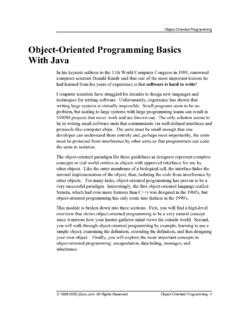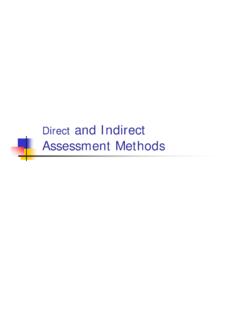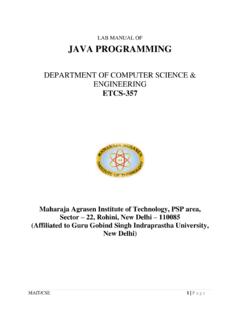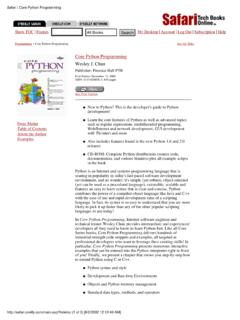Transcription of Network Programming
1 Network Programming 1996-2003 All Rights Programming -1 Network ProgrammingTopics in this section include: What a socket is What you can do with a socket The difference between TCP/IP, UDP/IP and Multicast sockets How servers and clients communicate over sockets How to create a simple server How to create a simple client How to create a multithreaded serverIntroductionThe Internet is all about connecting machines together. One of the most excitingaspects of java is that it incorporates an easy-to-use, cross-platform model fornetwork communications that makes it possible to learn Network programmingwithout years of study. This opens up a whole new class of applications is a Socket? java 's socket model is derived from BSD (UNIX) sockets, introduced in the early1980s for interprocess communication using IP, the Internet Internet Protocol breaks all communications into packets, finite-sized chunksof data which are separately and individually routed from source to destination.
2 IPallows routers, bridges, etc. to drop packets--there is no delivery guarantee. Packetsize is limited by the IP protocol to 65535 bytes. Of this, a minimum of 20 bytesis needed for the IP packet header, so there is a maximum of 65515 bytes availablefor user data in each are a means of using IP to communicate between machines, so sockets areone major feature that allows java to interoperate with legacy systems by simplytalking to existing servers using their pre-defined common protocols are layered on top of the Internet protocol. The ones weNetwork ProgrammingNetwork Programming -2 1996-2003 All Rights in this chapter are the User Datagram Protocol (UDP) and theTransmission Control Protocol (TCP). Applications can make use of these twoprotocols to communicate over the Network , commonly by building additionalprotocols on top of the TCP or UDP AddressesInternet addresses are manipulated in java by the use of the InetAddress takes care of the Domain Name System (DNS) look-up and reverselook-up; IP addresses can be specified by either the host name or the raw IPaddress.
3 InetAddress provides methods to getByName(), getAllByName(),getLocalHost(), getAddress(), AddressesIP addresses are a 32-bit number, often represented as a "quad" of four 8-bitnumbers separated by periods. They are organized into classes (A, B, C, D, andE) which are used to group varying numbers of hosts in a hierarchical to , inclusive. About 16 million IP addresses in a class to , inclusive. About 64 thousand IP addresses in aclass B to , inclusive. 256 IP addresses in a class C to , inclusive, denote multicast ENetwork Programming 1996-2003 All Rights Programming to , inclusive. Reserved for future IP address is special, and is reserved to represent the loopback or"localhost" numberThe port number field of an IP packet is specified as a 16-bit unsigned means that valid port numbers range from 1 through 65535.
4 (Port number 0is reserved and can't be used). java does not have any unsigned data types; java 's short data type is 16 bits, butits range is -32768 to 32767 since it is a signed type. Thus, short is not largeenough to hold a port number, so all classes which use or return a port numbermust represent the port number as an int. In the JDK , using an int with avalue greater than 65535 will generate an IllegalArgumentException. In theJDK and earlier, values greater than 65535 are truncated and only the low-order 16 bits are numbers 1 through 255 are reserved by IP for well-known services. A well-known service is a service that is widely implemented which resides at apublished, "well-known", port. If you connect to port 80 of a host, for instance,you may expect to find an HTTP server.
5 On UNIX machines, ports less than1024 are privileged and can only be bound by the root user. This is so an arbitraryuser on a multi-user system can't impersonate well-known services like TELNET(port 23), creating a security problem. Windows has no such restrictions, but youshould program as if it did so that your applications will work ComputingYou can use the java language to communicate with remote file systems using aclient/server model. A server listens for connection requests from clients acrossthe Network or even from the same machine. Clients know how to connect to theserver via an IP address and port number. Upon connection, the server reads therequest sent by the client and responds appropriately. In this way, applicationscan be broken down into specific tasks that are accomplished in data that is sent back and forth over a socket can be anything you , the client sends a request for information or processing to the server,which performs a task or sends data back.
6 You could, for example, place an SQLshell on the server and let people talk to it via a simple client "chat" ProgrammingNetwork Programming -4 1996-2003 All Rights IP and port number of the server is generally well-known and advertised sothe client knows where to find the service. In contrast, the port number on clientthe side is generally allocated automatically by the protocols used on the Internet (HTTP for example) are designed to bedriven from the command line. They send their requests and responses across thenet in plain text. One of the easiest ways to become familiar with networkprogramming and/or specific protocols is to use the TELNET application to "talk"directly to a server from the command Datagram Protocol (UDP)UDP provides an unreliable packet delivery system built on top of the IPprotocol.
7 As with IP, each packet is an individual, and is handled of this, the amount of data that can be sent in a UDP packet is limited tothe amount that can be contained in a single IP packet. Thus, a UDP packet cancontain at most 65507 bytes (this is the 65535-byte IP packet size minus theminimum IP header of 20 bytes and minus the 8-byte UDP header).UDP packets can arrive out of order or not at all. No packet has any knowledge ofthe preceding or following packet. The recipient does not acknowledge packets, sothe sender does not know that the transmission was successful. UDP has noprovisions for flow control--packets can be received faster than they can be call this type of communication connectionless because the packets have norelationship to each other and because there is no state destination IP address and port number is encapsulated in each UDP two numbers together uniquely identify the recipient and are used by theunderlying operating system to deliver the packet to a specific process(application).
8 One way to think of UDP is by analogy to communications via a letter. You writethe letter (this is the data you are sending); put the letter inside an envelope (theUDP packet); address the envelope (using an IP address and a port number); putyour return address on the envelope (your local IP address and port number); andthen you send the a real letter, you have no way of knowing whether a UDP packet wasreceived. If you send a second letter one day after the first, the second one may bereceived before the first. Or, the second one may never be why use UDP if it unreliable? Two reasons: speed and overhead. UDP packetsNetwork Programming 1996-2003 All Rights Programming -5have almost no overhead--you simply send them then forget about them.
9 Andthey are fast, since there is no acknowledgement required for each packet. Keep inmind the degree of unreliability we are talking about. For all practical purposes, anEthernet breaks down if more than about 2 percent of all packets are lost. So,when we say unreliable, the worst-case loss is very is appropriate for the many Network services that do not require guaranteeddelivery. An example of this is a Network time service. Consider a time daemonthat issues a UDP packet every second so computers on the LAN cansynchronize their clocks. If a packet is lost, it's no big deal--the next one will beby in another second and will contain all necessary information to accomplish common use of UDP is in networked, multi-user games, where a player'sposition is sent periodically.
10 Again, if one position update is lost, the next onewill contain all the required broad class of applications is built on top of UDP using streaming streaming protocols, receiving data in real-time is far more important thanguaranteeing delivery. Examples of real-time streaming protocols are RealAudioand RealVideo which respectively deliver real-time streaming audio and video overthe Internet. The reason a streaming protocol is desired in these cases is because ifan audio or video packet is lost, it is much better for the client to see this as noiseor "drop-out" in the sound or picture rather than having a long pause while theclient software stops the playback, requests the missing data from the would result in a very choppy, bursty playback which most people findunacceptable, and which would place a heavy demand on the UDP ServersTo create a server with UDP, do the following:1.










